 I’ve decided that I will be making two pies a year from now on, the Brandied Butternut Squash Pie from the peerless Melissa Clark that I made for Thanksgiving last year and this apple pie for July 4th. (I don’t think pies count as “massive.”) While I’ve made apple pies in the past, and I liked them okay, there were problems:
I’ve decided that I will be making two pies a year from now on, the Brandied Butternut Squash Pie from the peerless Melissa Clark that I made for Thanksgiving last year and this apple pie for July 4th. (I don’t think pies count as “massive.”) While I’ve made apple pies in the past, and I liked them okay, there were problems:
1. The apples always seemed to be partly raw.
2. The crust tended to be soggy on the bottom.
But in spite of these drawbacks I wanted to make an apple pie sometime during the July 4th weekend. This desire was mainly fired by a Sally’s Baking Addiction post in which she demonstrated how to do a lattice-topped pie crust. It was so pretty that I just couldn’t resist. (I probably wouldn’t bother with the lattice again and instead just do a solid top, but it was fun to do it at least once.) You can see from the picture that my lattice wasn’t perfect, but I was pretty pleased. I was even more pleased with the way it tasted. I had a fairly small piece at our July 6 cookout and then another piece for breakfast the next morning. And I’ll also point out that the entire filling had only ¾ cup of sugar total, or 144 grams, which translates into about 18 grams of sugar per serving. Not that bad! (I did have some vanilla ice cream with my evening portion, but I’m not going to figure the sugar content on that.)
I don’t have one go-to recipe for piecrust. If I’m making a pot pie or quiche I’ll usually go with the whole-wheat version in my King Arthur Flour whole grains cookbook,* but it doesn’t translate well for a sweet recipe. For the above-mentioned Thanksgiving pie I used Melissa Clark’s all-butter pastry with great success; for the apple pie I used Sally’s favorite recipe, which includes shortening as well as butter. (But I don’t use Crisco; I use Spectrum brand* non-hydrogenated shortening.) I was very pleased with the results for that also; I think that it’s a little easier to work with than the all-butter version and therefore a good choice for a two-crust pie. I don’t go the pastry-blender route as Sally recommends but instead just used my food processor; the results were perfectly fine. Just be sure to do the processing in short bursts. And I avoided the soggy bottom crust by putting the pie on a baking sheet (to catch any drips, although because of the pre-cooking that danger was avoided) and then putting the whole shebang directly on my pizza stone* after I’d let it get good and hot. I was very pleased with the consistency of the bottom crust.
As for the filling, I knew that I wanted to use a version that pre-cooked the apples, and I found one over at the New York Times cooking website. It worked really well with a mix of Honeycrisp and Granny Smith apples; I weighed the amount after I had peeled, cored and sliced them. That’s a lot of apples! And because the apples started out somewhat cooked down I didn’t end up with that empty space you sometimes get between the top crust and the apples in a conventional pie.
If you have a special meal coming up for which you’d like to make an all-American pie, then, I’d recommend following the links above. (Labor Day weekend might be a good target of opportunity.) People will react the same way to your homemade pie as they will to your homemade rolls: “You made this?” And you’ll know that it wasn’t all that hard.
Let me recommend that you serve your lovely pie with small scoops of good vanilla ice cream. No low-fat stuff. And puh-leeze, no Cool Whip! If you’d like a whipped topping instead of ice cream, use the real thing. Again, just a small dollop will do fine. There’s no point in eating a fake version just to save a few calories. If you feel that you just cannot eat the ice cream or whipped cream, might I suggest that you just eat your piece of pie plain? You’ve spent lots of time and effort on it, so enjoy it! Savor every mouthful.
(This post sure has a ton of links, doesn’t it? It’s all good stuff, I promise. Links with an asterisk are affiliate links.)